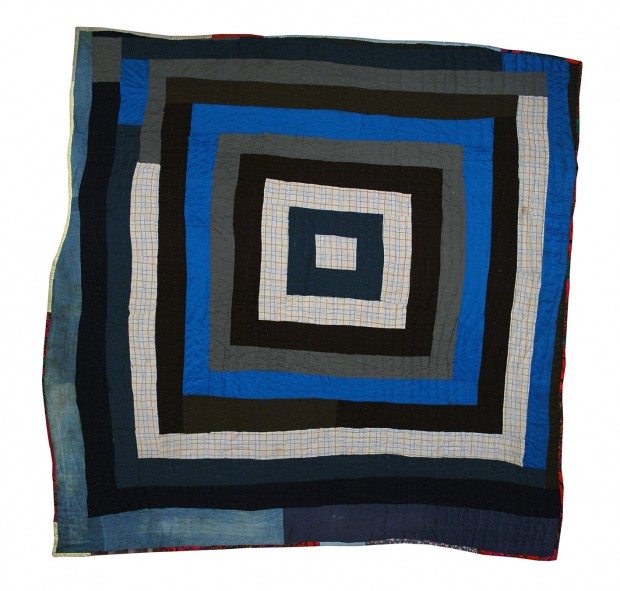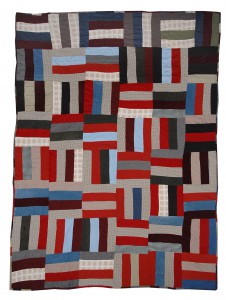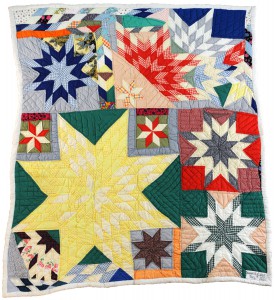
Lucreca Outland, “Roman Stripes Britchy Quilt,” 1989. Courtesy of the Montgomery Museum of Fine Arts.
From Heart to Hand: African American Quilts from the Montgomery Museum of Fine Arts
April 10 – June 22, 2014
DePaul Art Museum
DePaul University, 935 West Fullerton, Chicago, IL, 60614
What’s on view: A selection of quilts from the collection of the Montgomery Museum of Fine Arts in Alabama, produced by African-American women from the South.
Robin Dluzen: I’m fascinated by these quilts. By now I think we’re pretty accustomed to seeing traditional domestic handicraft incorporated into contemporary art, with artists like Rosemarie Trockel and Sanford Biggers. But seeing this quilting tradition directly—instead of filtered through the conceptual practices of artists from very academic backgrounds—is quite powerful.

Plummer T. Pettway, “Housetop/Strip Quilt,” ca. 1960-70. Courtesy of the Montgomery Museum of Fine Arts.
What struck me most is their scale. Since the majority of these quilts were created to be functional and large enough to cover beds, once they’re displayed on the wall, their scale rivals that of AbEx paintings. The fact that geometric abstraction has been practiced by African-American women on this scale since the 1800s (though this exhibition has examples from the 1950s on) is a refreshing parallel history to the white male-dominated one we’re used to.
Damien James: Agreed. Though the scale is typical of quilting, seeing these on a gallery wall was definitely powerful. I’ve never been interested in quilts as a form of artistic expression, but what I saw at DePaul opened my eyes to how unique and individual the medium could be.
The narrative quilts did less for me than the abstract quilts—they were just plain beautiful. Under the abstract quilt category, count Nora Ezell’s “Star Puzzle” and Mary Maxtion’s “Everybody Quilt. ” “Star Puzzle” took a standard quilting theme and exploded it, creating some surprising chaos. Maxtion’s “Everybody Quilt” relied on a standard interlocking pattern, but did so with succinct regard to color and motion. And it reminded me of several pairs of polyester pants I used to wear.
Robin: As much as I was also impressed by the abstraction in the show, I still found the narrative works more complex. All the figurative works were created by Yvonne Wells, a self-taught artist from Tuscaloosa, Alabama. Many of her pieces feature pretty straightforward content of righteous Christian imagery and depictions of Civil Rights heroes, composed in a way that recalls all sorts of historical methods of visual storytelling (stained glass windows, Japanese woodblock prints, etc.)
Wells seems to give her figures meaning (and “oomph”) through how she renders her figures, particularly the materials she chooses. In “Rosa Parks 1,” African American subjects are mostly created with patchwork-like shapes, while the white people are cut from a fabric pre-printed with Caucasian figures. Here, the whites are diminutive and static in a way that both wittily and poignantly expresses the rigidity of racist white society. That’s in stark contrast to the representation of Parks, who shown as dynamic and expressive in a style that we would most likely identify as “naïve.”

Lureca Outland, “Roman Stripes Britchy Quilt,” c. 1989. Courtesy of the Montgomery Museum of Fine Arts.
Damien: It’s exactly the “naïve”-leaning of Wells’s gestural figures that left me nonplussed. When I don’t feel the rendering, I’m apt to lose interest.
Regardless, Wells makes compelling work; it’s just not necessarily work I want to keep looking at. Still, there’s an undeniable charm in many of Wells’s quilts, particularly the Jackie Robinson piece. In that work, the baseball diamond was filled with the slices of apple-pie; just the type of Americana I’d associate with the medium.
Robin: I admit, I used to feel the same way about “outsider” and “naïve” art, though the years I’ve spent in Chicago have changed that. There is a big market for “outsider art” here, and more importantly, we’ve got a regional history of academically trained artists supporting and drawing from it. There is a real dialogue here; it’s another “art village” operating outside of what we think of as the “art world.”



Comments on this entry are closed.